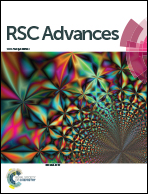Catalytic degradation of 4-chlorophenol with La/TiO2 in a dielectric barrier discharge system†
Abstract
Lanthanum (La) doped titanium dioxide (TiO2) introduced to the dielectric barrier discharge (DBD) system was successfully used to degrade 4-chlorophenol (4-CP). The photocatalytic materials were characterized by XRD, SEM, EDX and DRS techniques. The influence of the La doping ratio and pH on the degradation of 4-CP in the combined system of photocatalysis and plasma were investigated to evaluate the feasibility of the mixed degradation system. The 10 wt% La/TiO2 showed the highest percentage of 4-CP degradation (99.0%) and maximum rate constant (11.89 × 10−3 s−1). It was also found that the catalytic activity of 10La/TiO2 was higher than pure synthesized TiO2. Doped La effectively reduces the band gap, amends the surface and optimizes the crystal form of TiO2. Higher degradation efficiency of 4-CP was observed at higher pH values. The efficiency was 99.9% at pH 10.0 in this treatment system, while a decrease was observed at pH 2.0. Catechol, hydroquinone, benzoquinone and carboxylic acid were identified as the predominant aromatic intermediates for the degradation of 4-CP, and finally, transformed into CO2 and H2O.


 Please wait while we load your content...
Please wait while we load your content...